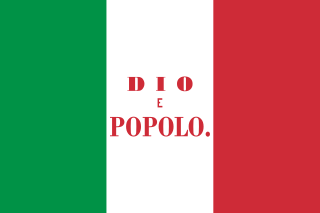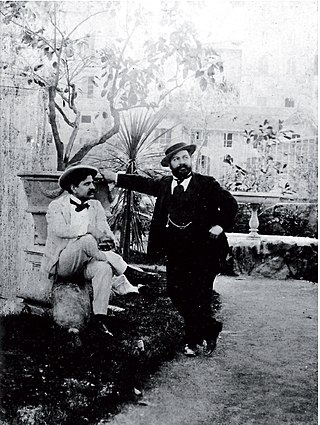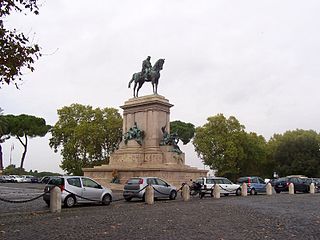
There are many busts of Italian patriots of the Risorgimento, and foreigners who fought with weapons or words for the unification of Italy, on the Janiculum in Rome.

There are many busts of Italian patriots of the Risorgimento, and foreigners who fought with weapons or words for the unification of Italy, on the Janiculum in Rome.
The Roman Republic commissioned marble busts to be displayed in the gardens of the Pincian Hill on May 28, 1849, for 10,000 lire. By the end of the war, the 52 busts had been made, but because of the temporary power of the Pope they remained in warehouses on Capitoline Hill.
In June 1851, Pius IX ordered the arrangement of most of the fifty-two busts in the gardens of the Pincian Hill. He excluded some busts because they were atheists. In 1860 the sculptors Achille Stocchi and Titus Sarrocchi were commissioned to create new busts. Their busts made a total of 228.
The initial placement of the statues took place between the end of 19th and early 20th centuries; the equestrian monument dedicated to Giuseppe Garibaldi was placed in 1896. In the 1920s, during the Fascist regime, the war memorial on the Janiculum was built for the Roman cause. It preserves the remains of some patriots.
The first restoration of the statues was done in the 1960s. Later more restorations were completed for the Great Jubilee, during which a Roman villa was discovered, and new statues were restored and relocated, including those of Anita Garibaldi, Giuseppe Garibaldi, and their children.
The crest of the Janiculum is dominated by the 1895 equestrian Monument to Garibaldi, designed by Italian sculptor Emilio Gallori. This site was chosen for its proximity to the Villa Doria Pamphili, where Garibaldi mounted a military defense of the short-lived Roman Republic in late April 1849. [1]
The hill also features a number of busts of historically significant Italians. All the busts were restored during 2010 and 2011, coinciding with the 150th anniversary of Italy. A 2011 guide published by the local Associazione Amilcare Cipriani group lists a total of 84 busts on the hill, 30 of them along the promenade north of the Garbaldi monument, and the rest to the south. [2] The busts have been prone to vandalism. [3]
Following is a partial list.
| Name | Sculptor and year of inauguration | Birth and death | Biography |
|---|---|---|---|
Luigi Masi  | Belpassi, October 3, 1897 | Petrignano (Assisi), 1814 – Palermo, 1872 | Staff, Brigadier General and commander of the Umbria brigade. During the second Roman republic Roman, he strenuously defended Porta Cavalleggeri, Porta Evangelica, and Leonine City with the Second Brigade of the town militia and with a light infantry battalion. He also distinguished himself during the uprising in Palermo of 1866. |
Luigi Ceccarini  | Giuseppe Trabacchi, 1893 | Rome, 1819–1887 | He was captain, and later major, of the papal army during the First Italian War of Independence. He fought in Venice and Vicenza. He became a colonel in 1849 and went to Rome to defend the Republic. He was excluded from the amnesty of Pius IX and went into exile in Piedmont. He also fought in the campaigns of 1859 and 1866. |
Pietro Pietramellara  | Alfredo Luzi, 1886 | Bologna, 1804 – Rome, 1849 | A marquis of liberal tendencies, he defended Vicenza in 1848 and defended the second Roman Republic. |
Alessandro La Marmora  | Riccardo Grifoni, June 7, 1886 | Turin, March 27, 1799 – Crimea, June 7, 1855 | A Piedmontese general who promoted the formation of the Bersaglieri. As a colonel, he took part in the Crimean War, where he became ill with cholera and died in 1855. |
Pietro Roselli  | Pietro Benedictines, 1886 | Rome, 1808 – Ancona, 1865 | As part of the papal army in 1848, he fought in the War of Independence and in 1849 defended the second Roman Republic. In 1860 he entered the regular army with the rank of lieutenant general. |
Alessandro Gavazzi  | Raffaele Cotogni, 1892 | Bologna, March 21, 1809 – Rome, January 9, 1889 | A Barnabite, he wrote liberal tracts from 1846 to 1847. He was chaplain of the legion of volunteers led by A. Ferrari, who fought in the Veneto. He left the Barnabites in 1848, and in 1849 defended the new republic. He went into exile for 10 years abroad before returning for the campaigns of 1859, 1860, 1866, 1867. |
Angelo Masina  | Michele Capri, 1886–1887 | Bologna, 1815 – Rome, June 3, 1849 | Commander of the Garibaldi Cavalry, he was killed in the Palazzo Corsini during the second defense of the Roman Republic. |
Ludovico Calandrelli  | Enrico Simonetti, 1886 | Rome, 1807 – Erzurum, 1855 | He was captain of the artillery that defended the Second Roman Republic. |
Luciano Manara  | Ilarioli Antonio, 1886 | Milan, March 23, 1825 – Rome, June 30, 1849 | He died during the second defense of the Roman Republic. |
Goffredo Mameli  | Attilio Temperoni, 1926 | Genoa, September 5, 1827 – Rome, July 7, 1849 | He died during the second defense of the Roman Republic. |
Nino Bixio  | Biagio Salvatore, 1887 | Genoa, October 2, 1821 – Sumatra, December 16, 1873 | |
Nicola Fabrizi  | Modena, 1804 – Rome, 1885 | ||
Natale Del Grande  | |||
Giacomo Pagliari  | Persico Dosimo, 1822 – Rome 1870 | Austrian officer who died in the breach of Porta Pia | |
Giovanni Nicotera  | Sambiase (Lamezia Terme), 1828 – Vico Equense, 1894 | ||
Alessandro Calandrelli  | Rome 1805 – Albano Laziale 1888 | Papal artillery commander and general | |
| Giacinto Bruzzesi | Cerveteri, 1822 – Turate, 1900 | Lieutenant of the Roman Republic, he was one of four gold medal recipients. | |
Filippo Cerroti  | Rome, 1819–1892 General | ||
Giacomo Medici  | Milano, 1817 – Rome, 1882 | Aide-de-camp to the king, senators, and marquises | |
Gaetano Sacchi  | Pavia, 1824–1876 | ||
Giuseppe Avezzana  | Chieri, 1797 – Rome, 1879 General | ||
Francesco Daverio  | Calcinate del Pesce (Varese) 1815 – Rome 1849 | Chief of Staff of the Roman Republic, died in defense of the Casino dei Quattro Venti on the Janiculum. | |
Colomba Antonietti  | Bastia Umbra, 1826 – Rome 1849 Wife of Luigi Porzi, she died at the port of St. Pancrazio | ||
Carlo Pisacane  | Naples, August 22, 1818 – Sanza, July 2, 1857 | Famous for the landing of the 300 at Sapri | |
Mattia Montecchi  | Rome, 1816–1871 | ||
Angelo Tittoni  | Rome, 1820–1882 | Commander of the Battaglione Universitario Romano in the battle of Vicenza, participated in the Roman Republic | |
Tommaso Salvini  | Milan, January 1, 1829 – Florence, December 31, 1915 | ||
Gustavo Modena  | Venice, 1803 – Turin, 1861 | ||
Ugo Bassi  | Cento, August 12, 1801 – Bologna, August 8, 1849 | He fought in the War of Independence, and he followed Garibaldi when he decided to continue fighting outside of Rome.He was captured by the Austrians in Bologna and executed by a firing squad. | |
Luigi Bartolucci  | Cantiano, 1788 – Nice, 1859 | General and friend of Garibaldi. He fought with Napoleon in the French invasion of Russia. He was captain in 1848 and deputy to the Constituent Assembly in Rome. As a General of a cavalry division of the Roman Republic, he heroically endured the French siege. After the fall of the Republic, he emigrated to England and Nice. He was awarded several orders and medals including the Legion of Honour and the order of the Iron Crown. | |
Righetto  | Bronze replica of the marble L'audace Righetto of Giovanni Strazza (1818–1875) created in 1851. | The brave Righetto (1851). Replica of the statue in the lobby of the grand staircase in Palazzo Litta. It portrays a 12-year-old child who died with his dog in 1849 while trying to stop a bomb during the defense of the Repubblica Romana in 1849. See Military use of children. | |
Menotti Garibaldi  | Mostardas, September 16, 1840 – Rome, August 22, 1903 | Son of Garibaldi | |
Ricciotti Garibaldi  | 1931 | Montevideo, February 24, 1847 – Riofreddo, July 17, 1924 | Son of Garibaldi |
Constante Garibaldi  | 1932, Constantino Garibaldi | Son of Ricciotti Garibaldi. He died in his early twenties in Argonne. | |
Bruno Garibaldi  | 1931 | Son of Ricciotti Garibaldi. He died in his early twenties in Argonne. | |
| Giacomo Venezian | September 9, 1895 | Trieste, 1824 – Rome, July 2, 1849 | Sergeant of the Medici Legion. In 1848 he led an unsuccessful revolutionary movement in Trieste. In 1849 he participated in the War of Independence. He was mortally wounded by the French on June 22, 1849 while defending the Casino Barberini. He died on July 2 at age 25. |
Maurizio Quadrio  | 1911, Spontini | Chiavenna, 1800 – Rome, 1876 | He participated in the November Uprising of 1830. He defended Rome in 1849. He went into exile in Marseille, Switzerland, and London. He was a member of the Action Party and the Italian Republican Party. |
Bartolomeno Filipperi  | 1911, Giovanni Cozza | Rome, 1833–1877 | In 1849 he fought on the barricades of Porta San Pancrazio and the event inspired his painting La difesa del Vascello. He went into exile in Nîmes for ten years. He followed Giuseppe Garibaldi in 1854 and 1867. |
Achille Sacchi  | 1911, Giovanni Prini | Mantua, 1827–1890 | A volunteer in the War of Independence, he tenaciously defended Porta San Pancrazio in 1849. He hatched an insurrection in 1853 with Mazzini, which led to his exile in Switzerland.He participated in Garibaldi's campaigns of 1859, 1860, and 1866. Afterwards, he returned to Mantua where he directed the local insane asylum. |
Quirico Filopanti  | 1911, A. Pantoresi | Budrio, 1812 – Bologna, 1894 | A writer with degree in mathematics and physics, he taught at the University of Bologna. He participated as a volunteer in the war of 1848. He was Deputy Secretary of the Constituent Assembly of the Roman Republic. In 1849 he went in exile in London. He was a deputy of the extreme left. |
Carlo Mayr  | 1911, M. Trispiciano | Ferrara, 1810–1882 | A soldier with Garibaldi, who was the interior minister of the Roman Republic.He was senator of the Kingdom of Italy. |
Carlo Bontemps  | 1911, Riccardo Rossi | ||
Domenico Piva  | 1928, Enrico Quattrini | Rovigo, 1826–1907 | He took part in the defense of Rome in 1849 and was wounded in the head. He was captured by Austrians and was forced to enlist in the Austrian army for eight years. He was discharged in 1860 and joined Garibaldi as a lieutenant in the Compagnia dei Mille. He became a lieutenant general. |
Nino Costa  | 1911, Giovanni Cozza | Rome, 1833–1877 | |
Raffaele Tosi  | 1949, V. Mancoratti | He took part in the campaigns of 1848–49, 1859–60, and 1866–67. The bust was proffered by the family. | |
Giuseppe Rosi  | 1912, G. Mangionello | Calcara di Ussita, 1798 – Rome, 1891 | He was a poet and pastor. |
Oreste Tiburzi  | 1911, Aurelio Temperoni | Rome, 1825–1849 | He was a friend of Philip Casini. |
Filippo Zamboni  | Trieste, 1826 – Vienna, 1910 | When he was 22 years old, he took part in the defense of the Roman Republic. He taught literature in the Accademia Commerciale di Vicenza. | |
Alessandro MelonI  | 1941, C. Docchi | Imola, 1813 – Rome, 1849 | As a young man he fought in 1848 in Vicenza and Venice. He was made a captain. He took part in the defense of Rome in 1849 and at Porta S. Pancrazio was mortally wounded in front of Garibaldi who promoted him to Major on the day of his death. |
Bernardo Serafini  | Serungarina, 1822–1906 | He was a liberal who conspired against the papal government. He fought in the War of Independence in Sicily. He was a deputy until 1886, when he joined the Senate. | |
Raffaele De Benedetto  | 1941, Benedetto De Lisi | Palermo – Rome, 1867 | A major under Garibaldi, he died during the 1867 Rome insurrection. |
John Whitehead Peard  | Giovanni Paganucci – 1904 set in Janiculum | Fowey 1811 – Trenython, 1880 | British captain and lawyer, colonel in Garibaldi's Expedition 1860, known as “Garibaldi’s Englishman”. |

The Quirinal Hill is one of the Seven Hills of Rome, at the north-east of the city center. It is the location of the official residence of the Italian head of state, who resides in the Quirinal Palace; by metonymy "the Quirinal" has come to stand for the Italian president. The Quirinal Palace has an extension of 1.2 million square feet.

Goffredo Mameli was an Italian patriot, poet, writer and a notable figure in the Risorgimento. He is also the author of the lyrics of "Il Canto degli Italiani", the national anthem of Italy.

The Roman Republic was a short-lived state declared on 9 February 1849, when the government of the Papal States was temporarily replaced by a republican government due to Pope Pius IX's departure to Gaeta. The republic was led by Carlo Armellini, Giuseppe Mazzini, and Aurelio Saffi. Together they formed a triumvirate, a reflection of a form of government during the first century BC crisis of the Roman Republic.

The Esquiline Hill is one of the Seven Hills of Rome. Its southernmost cusp is the Oppius.

The Janiculum, occasionally known as the Janiculan Hill, is a hill in western Rome, Italy. Although it is the second-tallest hill in the contemporary city of Rome, the Janiculum does not figure among the proverbial Seven Hills of Rome, being west of the Tiber and outside the boundaries of the ancient city.

Villa Borghese is a landscape garden in Rome, containing a number of buildings, museums and attractions. It is the third-largest public park in Rome, after the ones of the Villa Doria Pamphili and Villa Ada. The gardens were developed for the Villa Borghese Pinciana, built by the architect Flaminio Ponzio, developing sketches by Scipione Borghese, who used it as a villa suburbana, or party villa, at the edge of Rome, and to house his art collection. The gardens as they are now were remade in the late 18th century.

The Victor Emmanuel II National Monument, also known as Vittoriano or Altare della Patria, is a large national monument built between 1885 and 1935 to honour Victor Emmanuel II, the first king of a unified Italy, in Rome, Italy. It occupies a site between the Piazza Venezia and the Capitoline Hill. The monument was realized by Giuseppe Sacconi.

Anita Garibaldi, born Ana Maria de Jesus Ribeiro, was a Brazilian republican revolutionary. She was the wife and comrade-in-arms of Italian revolutionary Giuseppe Garibaldi. Their partnership epitomized the spirit of the 19th century's Age of Romanticism and revolutionary liberalism.

The Villa Doria Pamphili is a seventeenth-century villa with what is today the largest landscaped public park in Rome, Italy. It is located in the quarter of Monteverde, on the Gianicolo, just outside the Porta San Pancrazio in the ancient walls of Rome where the ancient road of the Via Aurelia commences.

The Pincian Hill Italian: Pincio[ˈpintʃo]; Latin: Mons Pincius) is a hill in the northeast quadrant of the historical centre of Rome. The hill lies to the north of the Quirinal, overlooking the Campus Martius. It was outside the original boundaries of the ancient city of Rome, and was not one of the Seven hills of Rome, but it lies within the wall built by Roman Emperor Aurelian between 270 and 273.

Mario Rutelli was an Italian sculptor.
Francesco Arquati was an Italian republican patriot, a notable figure in the Italian Risorgimento and a so-called martyr for the cause of a United Italy.

Francesco Daverio was a patriot of the Italian unification, Chief of Staff of the Roman Republic, and an engineer, who died on the Janiculum defending the Casino dei quattro venti.

The monument to Giuseppe Garibaldi is an imposing equestrian statue, which is sited on the highest point of the Janiculum hill in Piazza Garibaldi.

The Janiculum walls are a stretch of defensive walls erected in 1643 by Pope Urban VIII as a completion of the Leonine wall and for a better protection of the area of Rome rising on the right bank of the Tiber.
Ermenegildo Luppi (1877–1937) was an Italian sculptor.
Emilio Gallori (1846–1924) was an Italian sculptor, principally of historical monuments and religious statuary.

Ercole Rosa was an Italian sculptor.
![]() Media related to Busts in the Gianicolo park (Rome) at Wikimedia Commons
Media related to Busts in the Gianicolo park (Rome) at Wikimedia Commons